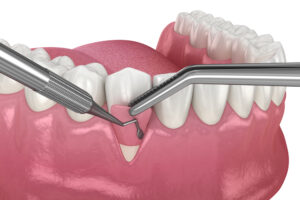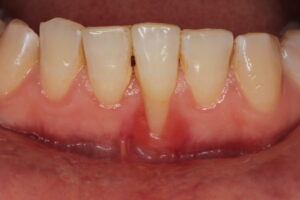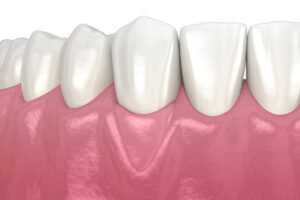Why is My Dentist Recommending Gum Grafts?
People hear the term “gum graft” or “skin graft” and understand that there is a need for new tissue for some reason or other. Your dentist may recommend a gum graft for a variety of reasons. The goal is to provide new healthy tissue in order to achieve a long-lasting attachment so that you keep your teeth as long as possible. Here is the answer to this question and others about gum grafts.
What is a Gum Graft?
A gum graft is a dental procedure that falls under the category of periodontics. Periodontics involves diagnosis, treatment, and management of the tissues around the teeth.. These tissues include the jawbone around the roots of the teeth (called the alveolar bone), a ligament connecting the teeth to the bone (called the periodontal ligament), and the gum tissues covering the bone. These tissues are responsible for holding the teeth in the mouth and providing the foundation for good chewing forces.
When you lose this supportive tissue through disease or trauma, you lose strength in the teeth. We can rebuild that support by replacing the tissue through a gum graft.
In a gum graft, your surgeon places a new layer of tissue over the area where it is lacking. Gum grafts can utilize a variety of materials, including synthetic matrix material and your own tissue taken from another area of the mouth where healthy gum tissues exist.
Gum grafting is a surgical procedure, and some people opt for sedation while undergoing this surgery. Sedation is not necessary, though.
What Dental Problems does a Gum Graft Fix?
In general, we use gum grafting to fix a lack of adequate gum tissues necessary for long-term support of the teeth.
 Gum Recession
Gum Recession
Gum recession can result from a variety of problems. The most common is periodontal disease or progressive gum disease. This bacterial infection causes a chronic inflammatory response that destroys the supportive tissues surrounding the teeth.
People may also experience gum result as the result of heavy clenching or grinding their teeth, inappropriate orthodontic movement, or severe crowding of the teeth. People may also cause gum recession by brushing too forcefully.
Lack of Attached Gingiva
Another potential reason for one to need a gum graft is a condition called a lack of attached gingiva. The gum tissues should attach to the bone underneath in a wide band across the majority of the teeth roots. The attached gingiva transitions to unattached where the loose tissue of the inner cheek meets the gums.
In some cases, a tooth or multiple teeth do not have an adequate amount of attached gingiva covering the roots, and they lack the support they need for healthy long-term function. A gum graft can replace attached gingiva.
What Will I Experience during a Gum Graft?
During the gum graft surgery itself, you should experience no pain because your dentist will use local anesthetic to ensure complete numbness in the surgical site. Many people choose to have sedation during this surgery so that they can “sleep” through the duration of it. Sedation is a wonderful option for those who feel anxious about the procedure.
If you remain “awake”, you might notice some pressure sensations, but you should feel no pain at all.
How Long is the Recovery from a Gum Graft?
 The recovery period following gum graft surgery occurs in a few phases of healing. Initial healing occurs within the first ten to fourteen days, after which acute inflammation and most pain is gone. Over the next four to six weeks, the “new” gum tissues form a solid attachment to the underlying bone.
The recovery period following gum graft surgery occurs in a few phases of healing. Initial healing occurs within the first ten to fourteen days, after which acute inflammation and most pain is gone. Over the next four to six weeks, the “new” gum tissues form a solid attachment to the underlying bone.
Maintaining strict adherence to your doctor’s post-operative instructions is essential for successful healing of gum grafts. This includes seeing your surgeon on schedule for consistent follow-up visits.
What if I do not Get the Recommended Gum Graft?
Gum grafts aim to add strength and support to the foundation around the teeth. They also cover exposed teeth roots, which helps some people manage sensitivity.
If your dentist has recommended a gum graft, and you decline to follow through with the surgery, you might experience a worsening of the problems necessitating the graft. Gum recession may worsen, or you may lose all attached gingiva over a tooth’s roots. These scenarios mean that you are losing structural support for your teeth.
Imagine a tree on a hill, whose roots are slowly becoming exposed by erosion of the soil around them. If that erosion continues, eventually the tree will have no foundation and will fall over. The same is true for our teeth. Without adequate coverage of our roots, they can lose so much support that they literally just fall out of our mouths.
If you experience any sensation of looseness or “wiggling” in a tooth, make an appointment to see your dentist as soon as possible. Loose teeth are not only worthless in providing chewing force; they also may predispose their neighboring teeth to disease. Don’t ignore severe gum recession or looseness in your teeth.
More Questions about Gum Grafts?
Call Designer Smiles to schedule a consultation with Dr. Ann. She can answer any of your questions about gum grafts and your specific need for one. Our goal is to help patients keep their teeth for a lifetime!
